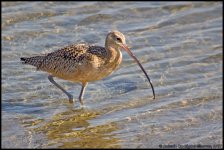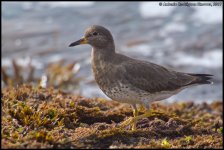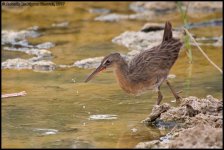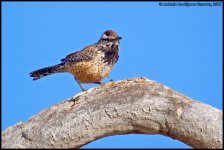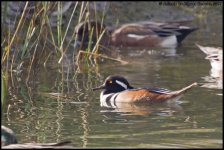Last November I did a short visit to South California. I had only about 5 days, thus I centered my visits in some concrete places: Bolsa Chica Ecological Preserve, the coast between Los Angeles and San Diego, Salton Sea, Big Morongo, Joshua Tree and Newport Back Bay, again near Los Angeles. Clicking in the links below you can find a complete report on each explored area, including pictures, maps and the list of species seen.
1. Bolsa Chica is an estuary with saltmarsh, mudflats, and open water, together with an upland mesa, that is an excellent birding spot at any time of year. It is home of the endangered Belding's sparrow, and it became a breeding ground for black skimmers, least terns, caspian and other tern species. It is located in coastal Orange County, very near to the main touristic attractions in Los Angeles. I visited it on November 11th. I was very lucky as I managed to see over 70 different species, including ruddy duck, marbled godwith, long-billed curlew, and least and western sandpipers.
2. Orange County South Coast to San Diego. On November 15, after renting a car, I moved from Anaheim to San Diego. My intention was to stop at different locations within the coast to observe birds. I was mainly interested in species associated with the rocky coast. An earthquake fault close to Corona del Mar, divides the Orange County coast in two well differentiated areas. The north is composed of sandy beaches, whereas rocky coast begins south of this city. Therefore, I drove below Corona del Mar, visiting first, Crescent Bay Point Park, and then the Treasure Island Park (indispensable!!) and La Jolla. During the afternoon I visited the Torrey Pines State Reserve. Here, I visited the interior chaparral area, as I had already achieved most of my objectives in the two previous stops. The next day I visited the San Diego area, specifically around Mission Bay (I had no time to visit more locations, although the San Diego area has other interesting birding spots). To choose the places to visit, I relied on the book "A birder's guide to Southern California" by Brad Schram, published by the American Birding Association.
3. Salton Sea (November 16-17th). Currently, the Salton Sea is California's largest inland body of water, with an average depth of 6 meters. The area originated millions of years ago, when sediments carried by the Colorado River closed the northernmost area of the Gulf of California. The basin has since been dry or filled with intermittent lakes depending on the river's contributions. By 1901, a canal was opened along an old course of the river to irrigate the dry, fertile basin. However, in 1904-1905 a flood inundated the area, by pouring about 63 billion gallons of water a day, and originating the current Salton Sea. The soils surrounding the Salton Sea are alkaline, and the farmers leach out the salts by flooding fresh water. This salt-laden water (together with pesticides) end on the Salton Sea, making, together with evaporation, that each year the Sea increases its concentrations of salts and toxins. In fact, it is one of the greater environmental problems in the United States. Despite this, the Salton Sea is a magnificent area to see birds. In addition to a long list of breeding species, hundreds of thousands of ducks choose their waters to spend the winter, including thousands of Snow and Ross geese. This was my main reason to visit the area, which certainly did not disappointed me. To choose the places to visit, I relied on the book "A birder's guide to Southern California" by Brad Schram, published by the American Birding Association. All my visits to Salton Sea were centered on its south end.
4. Big Morongo Canyon Preserve. Big Morongo (visited on November 18th) is an small oasis in a desertic area, with a fine grove of Frémont cottonwoods, a permanent stream, and thick stands of brush, all surrounded by several canyons. Attracts a good number of birds, mostly during migration. Here I spent the last hours of the day. I realized that this was an interesting place to explore, with beautiful landscapes. However, as I had not too much time I saw few species (as California towhee or cedar waxwing, among others).
5. Joshua Tree National Park. Joshua Tree National Park (November 19th) is a conjunction of two different deserts, defined by altitudinal differences and distinct plant and animal communities. Eastern half of the park, below 1000 meters above sea level, lies within the Colorado desert, that is part of the much larger Sonoran desert (which spans southern Arizona and north-western Mexico). The western half of the park, at elevations above 1000 meters, is Mojave desert habitat. Obviously, there is wide transition zone, which offers a higher biological diversity. As I was in the park only for one day, I only had time to visit the area corresponding to the Mojave desert, that, on the other hand, is the area where famous Joshua Trees are located.
6. Upper Newport Bay. Upper Newport Bay, also known as Newport Back Bay, is the largest estuary in southern California and one of the easiest to bird. It is a famous wintering ground for shorebirds and waterfowl, being also very interesting during migrations. Here I managed to see several ducks, including hooded merganser, lesser scaup, bufflehead, american wigeon or blue-winged teal, and shorebirds, as marbled godwit, long-billed curlew, whimbrel, or grey plover.
Please, if anybody detects a mistake in any identification, do not hesitate to indicate me.
Here I include also some pictures:
Picture 1 corresponds to a long-billed curlew (taken at Bolsa Chica).
Picture 2 is a surfbird, taken at Treasure Island Park (Orange County Coast).
Picture 3 corresponds to a Ridgway's rail (Salton Sea)
Picture 4 is a Cactus Wren (taken at Joshua Tree NP)
Picture 5 is a hooded merganser (Newport Back Bay).
Regards
1. Bolsa Chica is an estuary with saltmarsh, mudflats, and open water, together with an upland mesa, that is an excellent birding spot at any time of year. It is home of the endangered Belding's sparrow, and it became a breeding ground for black skimmers, least terns, caspian and other tern species. It is located in coastal Orange County, very near to the main touristic attractions in Los Angeles. I visited it on November 11th. I was very lucky as I managed to see over 70 different species, including ruddy duck, marbled godwith, long-billed curlew, and least and western sandpipers.
2. Orange County South Coast to San Diego. On November 15, after renting a car, I moved from Anaheim to San Diego. My intention was to stop at different locations within the coast to observe birds. I was mainly interested in species associated with the rocky coast. An earthquake fault close to Corona del Mar, divides the Orange County coast in two well differentiated areas. The north is composed of sandy beaches, whereas rocky coast begins south of this city. Therefore, I drove below Corona del Mar, visiting first, Crescent Bay Point Park, and then the Treasure Island Park (indispensable!!) and La Jolla. During the afternoon I visited the Torrey Pines State Reserve. Here, I visited the interior chaparral area, as I had already achieved most of my objectives in the two previous stops. The next day I visited the San Diego area, specifically around Mission Bay (I had no time to visit more locations, although the San Diego area has other interesting birding spots). To choose the places to visit, I relied on the book "A birder's guide to Southern California" by Brad Schram, published by the American Birding Association.
3. Salton Sea (November 16-17th). Currently, the Salton Sea is California's largest inland body of water, with an average depth of 6 meters. The area originated millions of years ago, when sediments carried by the Colorado River closed the northernmost area of the Gulf of California. The basin has since been dry or filled with intermittent lakes depending on the river's contributions. By 1901, a canal was opened along an old course of the river to irrigate the dry, fertile basin. However, in 1904-1905 a flood inundated the area, by pouring about 63 billion gallons of water a day, and originating the current Salton Sea. The soils surrounding the Salton Sea are alkaline, and the farmers leach out the salts by flooding fresh water. This salt-laden water (together with pesticides) end on the Salton Sea, making, together with evaporation, that each year the Sea increases its concentrations of salts and toxins. In fact, it is one of the greater environmental problems in the United States. Despite this, the Salton Sea is a magnificent area to see birds. In addition to a long list of breeding species, hundreds of thousands of ducks choose their waters to spend the winter, including thousands of Snow and Ross geese. This was my main reason to visit the area, which certainly did not disappointed me. To choose the places to visit, I relied on the book "A birder's guide to Southern California" by Brad Schram, published by the American Birding Association. All my visits to Salton Sea were centered on its south end.
4. Big Morongo Canyon Preserve. Big Morongo (visited on November 18th) is an small oasis in a desertic area, with a fine grove of Frémont cottonwoods, a permanent stream, and thick stands of brush, all surrounded by several canyons. Attracts a good number of birds, mostly during migration. Here I spent the last hours of the day. I realized that this was an interesting place to explore, with beautiful landscapes. However, as I had not too much time I saw few species (as California towhee or cedar waxwing, among others).
5. Joshua Tree National Park. Joshua Tree National Park (November 19th) is a conjunction of two different deserts, defined by altitudinal differences and distinct plant and animal communities. Eastern half of the park, below 1000 meters above sea level, lies within the Colorado desert, that is part of the much larger Sonoran desert (which spans southern Arizona and north-western Mexico). The western half of the park, at elevations above 1000 meters, is Mojave desert habitat. Obviously, there is wide transition zone, which offers a higher biological diversity. As I was in the park only for one day, I only had time to visit the area corresponding to the Mojave desert, that, on the other hand, is the area where famous Joshua Trees are located.
6. Upper Newport Bay. Upper Newport Bay, also known as Newport Back Bay, is the largest estuary in southern California and one of the easiest to bird. It is a famous wintering ground for shorebirds and waterfowl, being also very interesting during migrations. Here I managed to see several ducks, including hooded merganser, lesser scaup, bufflehead, american wigeon or blue-winged teal, and shorebirds, as marbled godwit, long-billed curlew, whimbrel, or grey plover.
Please, if anybody detects a mistake in any identification, do not hesitate to indicate me.
Here I include also some pictures:
Picture 1 corresponds to a long-billed curlew (taken at Bolsa Chica).
Picture 2 is a surfbird, taken at Treasure Island Park (Orange County Coast).
Picture 3 corresponds to a Ridgway's rail (Salton Sea)
Picture 4 is a Cactus Wren (taken at Joshua Tree NP)
Picture 5 is a hooded merganser (Newport Back Bay).
Regards
Last edited:




